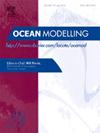Improvement in wintertime mixed layer depth simulation by CMIP6 compared to CMIP5 climate models
IF 2.9
3区 地球科学
Q2 METEOROLOGY & ATMOSPHERIC SCIENCES
引用次数: 0
Abstract
In this study, we assessed the simulated winter mixed layer depth (MLD) in the CMIP5 and CMIP6 models by comparing to Argo observations. Both the CMIP5 and CMIP6 models have well simulated the pattern of the winter MLD; however, there are large biases in the subtropical and subpolar regions, where the Subtropical Under Waters, Subtropical and Subantarctic Mode Waters, and North Atlantic Deep Water are formed. The CMIP6 models have not eliminated the simulation biases of winter MLD in subtropical and subpolar regions. However, Taylor Diagram (TD) analysis indicates that the CMIP6 models improved winter MLD simulation, showing less scatter and better TD scores than the CMIP5 simulations. Biases in the CMIP6 models were reduced by 11.60–27.55% in the subtropical to middle latitudes, and by 12.64–67.64% in the south/north subpolar Atlantic Ocean. With both the CMIP5 and CMIP6 models, the biases in winter MLD simulation are mainly attributed to inaccurate convection and stratification associated with heat/freshwater fluxes and thermohaline structures. Improving mixing parameterization is one of the most important updates in the CMIP6 models; however, it remains uncertain whether these improvements caused the winter MLD biases to decrease.
与CMIP5气候模式相比,CMIP6冬季混合层深度模拟的改进
在这项研究中,我们通过与 Argo 观测资料的比较,评估了 CMIP5 和 CMIP6 模式模拟的冬季混合层深度(MLD)。CMIP5和CMIP6模式都很好地模拟了冬季混合层深度的模式;但是,在亚热带和副极地区域,即亚热带底层水、亚热带和副极地模式水以及北大西洋深层水的形成区域,存在较大的偏差。CMIP6 模式并没有消除副热带和副极地地区冬季 MLD 的模拟偏差。不过,泰勒图(TD)分析表明,CMIP6 模式改进了冬季 MLD 模拟,与 CMIP5 模拟相比,散度更小,泰勒图得分更高。CMIP6 模式在亚热带到中纬度的偏差减少了 11.60-27.55%,在大西洋南/北次极地的偏差减少了 12.64-67.64%。在 CMIP5 和 CMIP6 模式中,冬季 MLD 模拟的偏差主要归因于与热/淡水通量和温盐结构相关的对流和分层不准确。改进混合参数化是 CMIP6 模式最重要的更新之一;但是,这些改进是否导致冬季 MLD 偏差的减小仍不确定。
本文章由计算机程序翻译,如有差异,请以英文原文为准。
求助全文
约1分钟内获得全文
求助全文
来源期刊

Ocean Modelling
地学-海洋学
CiteScore
5.50
自引率
9.40%
发文量
86
审稿时长
19.6 weeks
期刊介绍:
The main objective of Ocean Modelling is to provide rapid communication between those interested in ocean modelling, whether through direct observation, or through analytical, numerical or laboratory models, and including interactions between physical and biogeochemical or biological phenomena. Because of the intimate links between ocean and atmosphere, involvement of scientists interested in influences of either medium on the other is welcome. The journal has a wide scope and includes ocean-atmosphere interaction in various forms as well as pure ocean results. In addition to primary peer-reviewed papers, the journal provides review papers, preliminary communications, and discussions.
 求助内容:
求助内容: 应助结果提醒方式:
应助结果提醒方式:


